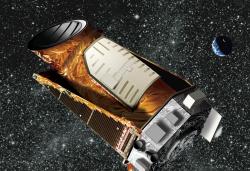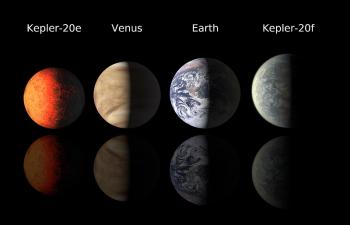Kepler Mission

Credit: NASA/JPL-Caltech
Kepler was a NASA mission to find exoplanets which are a similar size to Earth. NASA launched the mission in 2009. Kepler looked into space from its position in orbit around the Sun.
Kepler studied an area of the Milky Way and looked for exoplanets near to the 'habitable zone'. This is the area around a star where it is not too hot or too cold for liquid water to exist on the surface of the planet. Scientists think this may be the best place to look for life. Kepler also estimated the number of stars in the Milky Way which have planets.
Kepler's science tools let it measure the brightness of over 145,000 Sun-like stars. Scientists hunted for exoplanets in this data using the transit method. This looks for dips in the stars' brightness caused by a planet passing between us and the star.

comparison to the Earth and Venus
Credit: NASA/Ames
During its lifetime, the Kepler space telescope discovered over 2,600 exoplanets, including:
- Jupiter-sized planets very close to their star
- large Earth-like planets
- systems where a planet orbits two stars (a binary star)
- planets in the habitable zone of their star
In 2012, 3 years into the mission, one of Kepler's steering devices stopped working. A second device broke in 2013, which meant that Kepler could not continue with its primary mission. NASA announced K2, a new mission plan which could continue despite the broken steering devices. The K2 mission studies habitable planets around smaller, dimmer stars. The K2 mission ended in 2018 when the telescope ran out of fuel.

